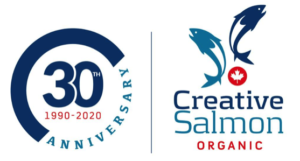
Creative crew member Jamie Jack at the helm of Creative’s Akva inside feeding system.
Feeding Creative Salmon’s Chinook a natural and nutritious diet is an essential part of their distinct egg-to-plate process.
And while the food they feed their fish hasn’t changed much since Creative started growing organic, how the food gets to the fish has changed dramatically over the last 25 years, says Ian Francis, Creative’s Operations Manager.
“Since I started in 1996, everything – our infrastructure, equipment, technology, and processes – has changed,” Ian says. “How we feed is a really good example of this.”
Twenty-five years ago, Creative’s salmon were fed by hand. “We would take buckets of feed and use milk jugs cut in half as scoops to throw the feed into the pens,” says Ian.
Back then, it was a lot of work for the Creative crew to fling multiple buckets of feed into the pens each day. And measuring how hungry the fish were and how much they were eating was a manual process, too.
“We relied on how the fish were reacting on the surface of the water and other visual clues, like if they were spitting out pellets, to know when they were full.”
The first major evolution began in the late 90s when cameras were lowered into the pens to get a view under water and learn more about the fish while they ate. Still,
getting the food into the pens was done by hand.
A few years later, the cameras were combined with automatic feeding systems that used blowers to propel the pellets over the surface of the water, but since the systems were independent and standalone, they required mobile stations that had to be wheeled and managed pen to pen.
Now, feeding is fully automated and directed by one Creative crew member in a control room, which frees up rest of the team to do other important tasks on site.
“The cameras are on pulleys that move up and down and side to side, and the automatic feeders are controlled remotely,” says Ian. “Now more than ever we’re able to
collect and use data to make predictions on size and yield. We have a lot of control over the feeding process.”
That control of the feeding process also helps to ensure the feed goes where it’s intended – to the fish until they are satiated and not to the ocean bottom.
Technology is truly driving modern aquaculture, says Ian.
“It’s cool to witness the change in our industry. When people ask me how things used to be done, I look back and nothing is the same.”

